Shout out to our favorite Californian, Elizabeth, for suggesting we put more "How to take care of your jewelry" information up here. Your wish is our command!

Good rule of thumb for pearl jewelry - especially necklaces, earrings, and bracelets: "Last On and First Off."
The nacre of the pearl is the outside part of the pearl we see and love. It is what gives the luster to pearls and provides the depth of color - think of the term pearlescence. Well, you want to put your pearls on AFTER you put on any make-up, hair treatment, and even perfume. That kind of material can build up on the pearls and a) ruin the luster or b) in extreme cases even damage the nacre by eating away at it.
At the end of the day, you want to remove your pearls BEFORE you start your ablutions for the same reasons. You don't want soap or some other cleaning product that may be harsh to come into contact with your pearls.
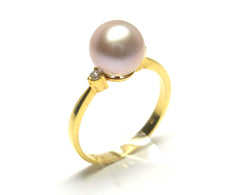
We often tell people to do the dishes with their wedding rings on - the hot soapy water disolves the oily residue that makes diamonds lose their sparkle.
If you have a pearl ring - NEVER do the dishes with it on. They way the vast majority of pearls are attached to rings (like the one above), and many earrings and pendants for that matter, is when the pearl is half-drilled and then attached to a post using expoxy. Even the best epoxy will loosen after exposure to water.
I cannot tell you the number of pearl rings I have seen over the years where there is nothing left of pearl's nacre. The seed pearl is still on the ring, but the good part with the luster and shine has been eaten completely away.
So - please keep ALL of your pearl jewelry our of water - even showers or baths. And because of chlorine in pools and even WORSE chemicals in hot tubs - never, ever, ever ever go in a pool or hot tub with your pearl jewelry on.
Your rings work hard to glamorize your hand - give them a Spa Day at Chimera Design.
We will start with an inspection of the ring. We will make sure the tips, prongs, channels, and bezels are in good shape for keeping your diamonds and gemstones secure in the mounting.
The it is off to the back room for an invigorating 2850 rpm session with our Handler Buffer. This will remove surface scratches and return your precious metal to a nice shine. Our jewelers rouge is especially formulated to clean and polish.

From there your ring will be transferred to our Branson 2510 heated ultrasonic where any dirt and debris will be gently shaken by the soothing 40kz sonic waves.

Then it is a short hop over to our 1300 watt Steam Dragon steamer for a purifying blast of vaporized distilled water at 90-125 psi. This will remove any residual jewelers rouge and gra-do!
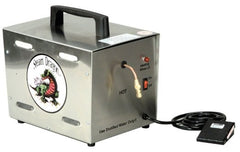
A day of luxury for your ring - including a FREE inspection - is only $15.00 per ring.
Did you ever notice how some diamonds sparkle a whole lot more than others? Well, it could be because of the way they were cut. A round diamond cut deeply causes the light to go out of the bottom - we call extreme cases of this Nail Heads. If the cutter shapes it too shallow - then the diamond can appear lifeless - we call them Fish Eyes.
A diamond cut to ideal proportions will return light like nothing else. No other gem can take light in and shoot it back at you like a diamond.

A couple of years ago we met Michael. He is a diamond cutter from New Jersey and is a master of his craft. When he stopped in the shop to show us what he could do, we bought one of his diamonds on the spot (Cliff never does that!). Since then we have introduced couples to his sparkle-fest diamonds. Laurie was so impressed, she wanted two of them for earrings!
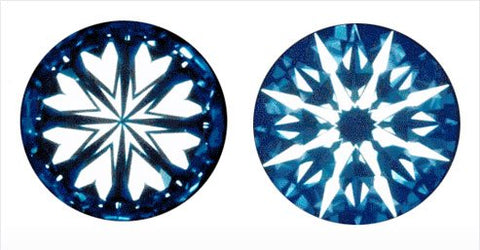
There is one company that has been marketing ideal cut diamonds by showing customers the hearts and arrows visible in their diamonds using a viewing device. Te result is the heart shape patterns (above left) seen from the bottom of the diamond and the arrow patters (above right) seen from the top down.
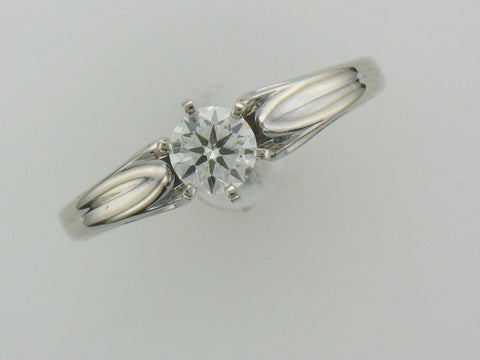
The diamonds Michael cuts are done so well, you do not even need a special viewing device to see the arrow patterns! The ring above is set with a .50 ct VS2 I diamond Michael cut and the one below features an .81 ct from Michael.

Ideal cut diamonds at Chimera Design - all the sparkle for less money!
Please come in and let us show you what a well cut diamond looks like -
we love to show off Michael's skills.
Spend any time at our store and you will probably hear one of us talking about gemstones that are "lab grown" or "lab created". Or you might read that somewhere on the net or hear it on one of the jewelry channels. So, what the heck does it mean?
There is a very big difference between a "synthetic" ruby and a "lab created" ruby. A "synthetic" ruby can be any material that is manufactured to have the same color as a ruby - it can be any number of materials including plain old glass. A lot of antique jewelry contains colored glass that looks like ruby, sapphire or other gems.
On the other hand a "lab created" or "lab grown" ruby is a gemstone where the crystal material is grown in a laboratory that duplicates the temperatures and conditions that exist when natural ruby crystals grow in the Earth.
Many people believe growing gem crystals in a lab is a fairly recent development, but Carroll Chatham perfected growing emerald crystals in 1938. Once he had the process down for emeralds he went on to grow perfect rubies and sapphires.
These are emerald crystals we purchased from Chatham Labs in California. It takes almost a year to grow emerald crystals big enough to facet into gemstones. (It takes about 90 days to grow sapphires and rubies.)
After a year, emerald crystals are big enough to be cut and polished into gemstones that are ready for jewelry. Natural emeralds as free of imperfections as those pictured above are possible to find, but they can cost tens of thousands of dollars. On the other hand, lab-grown emeralds cost hundreds of dollars.
Here at Chimera, we love ALL kinds of gemstones. We have a great source in Michigan for natural rubies and sapphires, but we also make a lot of our jewelry using lab-grown gems from our supplier in New Jersey (they have great prices, which we pass along to you.)
We also have beautiful jewelry from our friends at Strellman's. Almost all of the pieces in the Strellman line utilize lab-grown gems. This has been the case since the beginning when Mr. Strellman perfected his Lighthouse Lens cut (seen below). In order to produce this unusual cut, the amount of waste that occurs by cutting the stone along both axis' would make the use of natural rubies and sapphires not only cost prohibitive, but it would be a terrible waste of gem material.
One last note - diamond crystals, made of pure carbon, are also being grown in laboratories. I do not mean Moissanite, cubic zirconia or other diamond substitutes, but pure carbon crystals. However, at this point the price difference between lab-grown diamonds and natural diamonds is only 15-20% and has not really captured jewelry shoppers with the exception of those who would prefer to buy a man-made gem because of the environmental aspect.
But you can be sure as the technique for growing diamonds spreads and is put into practice more places, the price will drop to a place where it will be similar to what has happened with rubies, etc.
If you have a question about jewelry, diamonds, or gemstones - send to Cliff and he will do his best to answer it for you.
Colored Diamonds From The Laboratory
We have a line of colored diamond jewelry at Chimera.

The colored diamonds we sell (usually) are natural, white diamonds that have been changed into colored diamonds. There are three methods that can be used singly or in combination with each other depending on the color desired.
Electron Irradiation - a pulsed beam of electrons that will induce color into the diamonds is fired at them. The light absorbing pattern is changed and so is the color. Used alone, this process gives diamonds a blue or greenish blue color.
Annealment - To expand the range of colors, super heating them in an oxygen-free environment in temperatures 900 degrees and higher allows us to get other shades of color. The atomic structure of the diamonds rearrange, and a new palate of colors is possible.
High Pressure High Temperature (Hpht) - The HPHT process recreates the heat and pressure that creates diamonds initially in the Earth. Sophisticated machinery is programmed to accent conditions to get yellows, oranges, and greens.
There is a fourth method consisting of coating the diamond, which is used to create a truly pink color. The coating is done at the pavilion - the lower part of the diamond. This allows the color to shine through the entire diamond.

The first three treatments are more stable than the fourth. Diamonds that have been irradiated and/or annealed will not fade over time and they will wear like a normal diamond. The only caveat is that when being worked on by a jeweler, they need to be careful NOT to expose the diamond to heat in excess of 900 degrees which could occur when sizing a ring.
The HPHT method requires no caution of any kind.
The technology creating colored diamonds has moved forward tremendously in the last decade. When we first opened in 2002, treating diamonds was reserved for those very low on the clarity scale (I1 to I3) because the science was very in-exact as to the results. Sometimes they came out looking terrible. Blue ones could be all over the color spectrum and it was hard to create diamonds that were a good color match even when they were treated together.
Fast forward to the present day, and companies like Lotus Color can provide colored diamonds with better clarity (SI1-2) and with wonderful consistency. This makes it much easier to design and build colored diamond jewelry that is affordable and beautiful.

NATURAL COLORED DIAMONDS
They exist and they are extremely rare and costly. A 9.75 ct natural blue diamond (above) was auctioned in 2014 for 32.6 million dollars. Pink diamonds are found in Australia in very limited quantities and typically command prices in excess of what most of us can handle.
Typically a yellowish tint causes the price/value of a diamond to go down. That is true until the saturation of the yellow color reaches what GIA terms "Fancy" and then the price jumps up like a ROCKET!
Conclusion - creating colored diamonds in the lab is a wonderful way to make the long lasting beauty of colored diamond jewelry something that regular people can afford and appreciate. We are excited to offer colored diamond jewelry in our store and to you online.
We are very excited about our new online Chimera Showcase - you can design jewelry, insert various size, color, and shape gemstones and diamonds into YOUR choice of metals. Not only will you get instant visualization of your creation, but you will also have an estimated price that will change when you make changes in the piece, (e.g. from 10kt to 14kt gold or by substituting one gem for another).
This is some of the most fun you can have with jewelry online - we guarantee it.
Deb came in with a couple of diamonds and the desire to make a ring with them that would also incorporate her birthstone - Emerald. We went to the Chimera Showcase and looked around. She loved the contemporary look of the half bezel settings in this ring. We tried several shapes for the center lab-created emerald (Princess cut above), and she settled on a round one that would be slightly larger than her two diamonds - the diamonds are 5mm and the emerald is 6mm.
Once Deb settled on a design, we secured a price and placed the order. Her custom-designed ring was delivered about 10 days later for her to inspect before we set the gems. One great aspect - the jewelry from our Showcase is ALL made in the US - by our friends at Stuller in Louisiana.
To give you an idea of how accurate the computer images are, here is a picture of the finished ring with the 6mm center and Deb's diamonds. We LOVE technology!
One more thing about our Showcase - Don't worry, we are not trying to lure you into designing a $10,000 piece and then buying it! You CANNOT purchase your design directly from the website.
What you can do is save the final design(s) you like and then Cliff will be notified and contact you with an accurate price quote - how cool is that?
Please follow this link to our Online Chimera Showcase and have some fun designing rings, pendants, or earrings with the easy-to-use software. If you end up with a design you really love, save it and Cliff will contact you with a quote. Easy peasy!
Cliff has been selling diamonds for over 18 years now. He earned his Diamonds Graduate certification from GIA in 1998. Over the course of his career, he has sold clarity enhanced (CE) diamonds to a lot of people.
So what does "Clarity Enhanced" (CE) mean?
The imperfections in diamonds are called "inclusions" if they are inside the diamond and "blemishes" if they are on the outside. There is one particular type of inclusion that can be "repaired" using the clarity enhancement process: a feather. A feather is an inclusion that reaches the surface of the diamond. This picture shows a nice close up of a feather:
In the clarity enhancement process, a clear glass-like filler is put into the feather at an extremely high temperature and under very high pressure. (The industry guards the specifics, as you might imagine.)
Anyway, the material has the same reflective properties as a diamond, so you do not notice it unless you examine the diamond under magnification. It is also very noteworthy that the lab at GIA has weighed clarity enhanced diamonds before and after the treatment, and since the amount of material used is so minute, it adds no weight to the diamond. Very important since diamonds are sold by weight. GIA does NOT certify CE diamonds, but other labs do.
The CE process is NOT a miracle worker - you cannot take a I2 clarity diamond and turn it into a VS clarity stunner. Most times a diamond will move up one or possibly two notches on the clarity scale. That being said, what the CE translates to in terms of your pocketbook is that you can save about 30% by purchasing a CE gem.
Here are a couple of examples of the difference the CE process can make:

The top example has multiple feathers while the lower one has a very noticeable feather almost dead center on the diamond. The CE process renders them pretty much invisible. We say "pretty much" invisible because the process can be detected using magnification. Turning the CE diamond while examining it will produce a "flash" of color - most times a purple or orange or combination.
Here is an excellent photo of filled feathers demonstrating the purplish flash -

Any CE diamond we sell has a Lifetime Warranty on the process.
CE diamonds are not for everyone - but our attitude is that they are just another enhancement. Shoot, if you take a look at a diamond crystal the way they come out of the ground, you might not be impressed. You would probably walk right by one if you didn't know what you were looking for. It could be argued that cutting and polishing the diamond is a "clarity enhancement".
Here is a totally natural diamond crystal before cutting and polishing:
The ring below is an example of jewelry we made using clarity enhanced diamonds. The person who owned this ring saved about $2,000 by choosing a CE diamond. It was cut to ideal proportions and sparkles to beat the band!
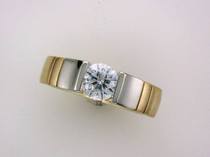
One last example: Two CE diamonds put into halo-style earrings. They weigh a total of 2.13 ctw and are accented by .22 ctw of diamonds. All in all, a gorgeous pair of earrings at a wonderful price, thanks to the clarity enhancement process. By using CE diamonds, this couple saved almost $3,000.00.
Hopefully you learned a little bit about CE diamonds. If you should have any questions, feel free to email or call Cliff - he loves to talk about diamonds.
Information about the care, cleaning, and manufacture of fine jewelry.
Swimming pools, hot tubs and your jewelry.

The short answer to the question above is: NO to the pool and NO-NO-DEFINITELY NOT to the hot tub.
A few words of caution about SWIMMING POOLS and HOT TUBS. We do not recommend that any fine jewelry be worn in public swimming pools or hot tubs. Chlorine is a corrosive chemical - it won't do any harm to diamonds, rubies, sapphires, and some other gemstones, but it is not good for your white or yellow gold to say nothing of sterling silver.
Chlorine can also discolor and/or prematurely wear out your watch - even watches rated to be underwater. (See our blog post on that subject: Watch Ratings)

Hot tubs are waaay worse than pools because in addition to harsh chemicals, you have the addition of high temperatures AND the pressure of the water coming out of the jets. We do not recommend that any jewelry or watches be worn in hot tubs. Even watches that are rated to go under water to some degree can be infiltrated by the water coming out of the jets.
Hot tubs are great for humans - they are a TERRIBLE environment for your jewelry and watches. Take the little bit of extra time to remove your jewelry and watches BEFORE you get in.
Kevin asked if it is safe to wear his titanium ring in a hot tub on a daily basis. My answer to that would be.....maybe. If the titanium has any kind of enameling or stone of any kind in it, then NO. If it is a plain band, there will probably NOT be a problem - but if it has any type of a finish on it, you might find that a daily dunking in the chemicals would change the appearance of even a titanium ring. Best bet - take it off - take it ALL off!!
I would make the same recommendation for those folks with tungsten or tungsten carbide rings. We sell them and I wear them and I would take mine off before spending time in a hot tub. Heat and chemicals wreck havoc!
.
Answer: Two-thirds of all watches are designated water resistant.
(Government guidelines prohibit manufacturers from labeling their watches "waterproof.") While you might think a water resistant rating such as "water tested to 50 meters" would mean that someone could safely wear a watch, say, scuba diving, it's really not that simple.
Why? Because testing is done in still water, with a stationary watch. Movement greatly increases pressure, so it's necessary to translate the water resistance ratings into practical guidelines.

The following scenario happens in our store almost every Spring, when people are returning from vacation. A guy comes in with a watch rated for 50 feet that is full of water - heck, he was only swimming in 8 feet of water!!
From the least to the most water resistant, the ratings are as follows:
- Water Resistant - These watches have withstood testing to depths of 24 to 30 meters (100 feet) and will tolerate splashes of water or rain, but should not be worn while bathing, showering, washing dishes, swimming or diving. Watches with this designation will have the words Water Resistant engraved on the case back.
- Water tested to 50 meters (165 feet) - Okay for showering, bathing, dish washing and swimming in shallow water. Not while snorkeling or scuba diving. The designation engraved on the case back will be "Water Resistant 5 BAR" (BAR is a European equivalent of the international measurement ATM, or "atmospheres." To calculate the water-tested depth in meters, multiply the BAR number by 10.)
- Water tested to 100 meters (330 feet) - These watches are suitable for swimming and snorkeling, but not scuba diving. The case back designation will read "Water Resistant 10 BAR".
- Water-tested to 150 meters (500 feet) - These watches can be worn for general water sports, including snorkeling. The case back designation is Water Resistant 15 BAR.
- Water tested to 200 meters (660 feet) - These watches can be worn for general water sports, including snorkeling and skin diving (without scuba gear). The case back designation is Water Resistant 20 BAR.
- Diver's 150 meters (500 feet) - Meets ISO standards and is suitable for scuba diving.
- Diver's 200 meters (660 feet) - Diver's watches with the Water Resistant 20 BAR designation on the case back are our most water-resistant models.
Taken from Seiko USA website
Information about the care, cleaning, and manufacture of fine jewelry.
The importance of jewelry maintenance.
Jewelry Maintenance - this is a serious subject. For most people, a diamond ring represents the biggest jewelry investment they have. Most diamond rings - engagement, wedding, or anniversary rings - are worn 24/7/365. Just like anything else - your jewelry needs to be maintained - especially a ring on your finger.
When your ring is new - the diamond(s) is secured by prongs and tips.
The tips on the prongs come up over the edge of the diamond and help to hold it secure in the mounting. Over the years you put your hand (ring) in and out of your pockets, in and out of gloves, and generally wear the heck out of it. That is a good thing - but you should have your rings inspected at LEAST once a year. A competent jeweler can look at the condition of your ring and know if your diamond is secure in the mounting.
Look at the picture of the new ring - then compare the tips on it with the other examples. (These are actual rings that have come in our shop.) Tips and prongs can be replaced - for much less than the cost of a diamond! Most ladies will get 8-12 years wear - but we know ladies who wear tips down in 3 years and sometimes even quicker.
GET YOUR RINGS INSPECTED!!
We do not charge for inspection, nor do most jewelry stores. Let a pro take a look for you at least once or twice a year. It can save you big money to say nothing of the sentimental value.

This is a new ring. Notice the tips come up
over the edge of the diamond, holding it in place.

You can see how the tips have worn away,
this diamond is ready to fall out.

Another example. This diamond has a 6
prong head, but 3 of the 6 are GONE and
the other 3 are very thin. DANGER!!!

One last example - see how the end of this diamond is exposed and two of the other four prongs are essentially gone.































